|
Home » Sponsored » Pi Speakers » 12π basshorn subwoofer - the best yet!
| 12π basshorn subwoofer - the best yet! [message #51447] |
Thu, 04 October 2007 14:33  |
 |
 Wayne Parham
Wayne Parham
Messages: 18984
Registered: January 2001
|
Illuminati (33rd Degree) |
|
|
I designed the 12π basshorn subwoofer as a signature statement product, the best high-fidelity and the highest SPL from 30Hz to 100Hz. It's a no-compromise design.
- Push-pull drive reduces distortion. The second harmonic is cancelled and horn folding reduces harmonics from third up. So harmonic distortion is very low.
- The cooling plug keeps the motors cool, so there's less electro-mechanical parameter shift as power is increased. Sound quality is excellent at low, moderate and even high power levels, and the system is more robust.
- Ample mouth area and flare profile along with careful selection of front and rear chamber sizes makes the response curve smooth. Where some basshorns get peaky when used outdoors unless used in groups, the 12π basshorn response is nice and smooth.
- Maximum SPL is increased when several 12π basshorns are clustered in groups, but this is not required to smooth response. Sound quality is excellent even when just one π basshorn subwoofer is used.
All of these qualities were brought together into one design, making it the best quality subwoofer for high-fidelity and high output. It delivers in both of these areas, in my opinion, being the best subwoofer you can get for the 30Hz to 100Hz subwoofer range.
See the response curves below. The graph on the left shows response of a single 12π basshorn with 1.0 watt input signal. The graph on the right shows response of a group of horns.
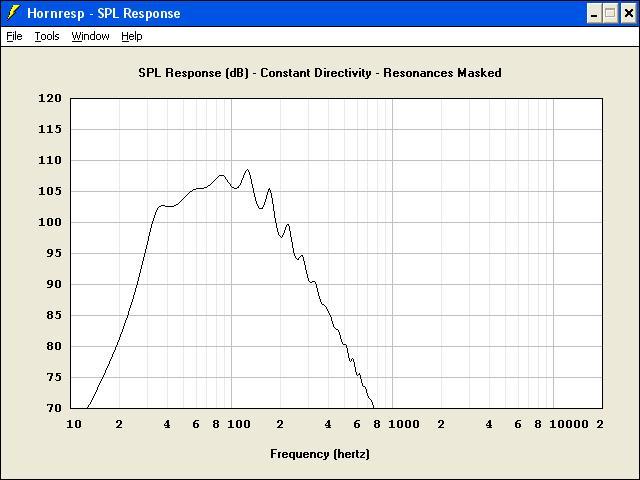 12π basshorn design, single horn response
12π basshorn design, single horn response
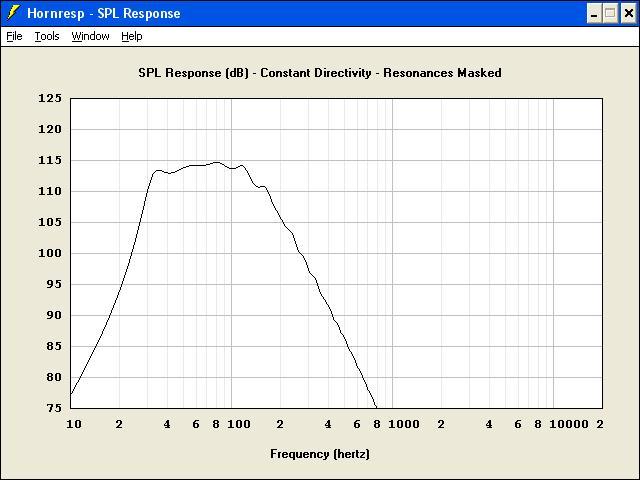 12π basshorn design, group of four
12π basshorn design, group of four
The prototype was able to deliver all the things hoped for in the original design goals. The only thing that was difficult was front chamber size. The design called for 20 liter combined front chamber volume and 50 liter rear chambers. The magnet in one of the front chambers made it difficult to make small unless fill was used. Even then, adding enough fill to reduce chamber volume to the right size would make assembly and service difficult, so I decided to make that front chamber as small as practical, and to match the other side to it. The end result was approximately 30 liters front chamber volume.
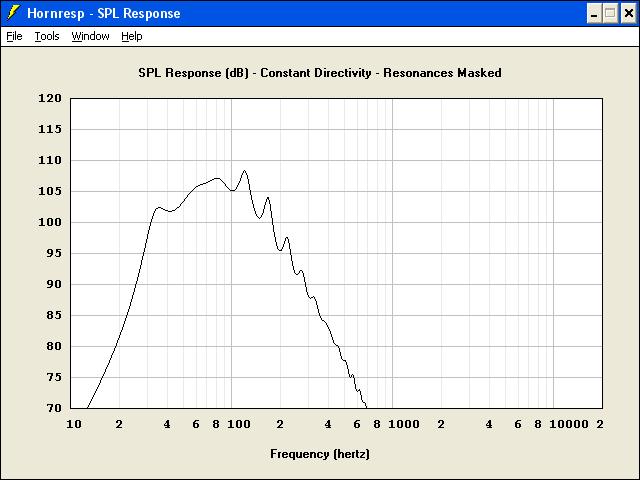 12π basshorn prototype, single horn response
12π basshorn prototype, single horn response
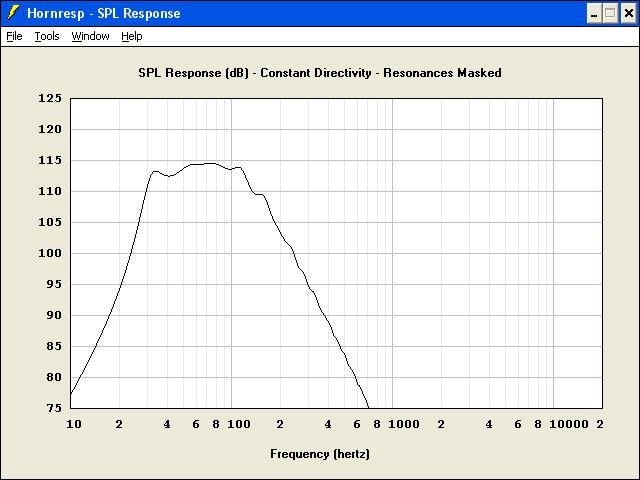 12π basshorn prototype, group of four
12π basshorn prototype, group of four
Notice a slight dip around 42Hz in the prototype, due to front chamber being larger (30 liters) than the original design (20 liters). But response was still very good, and I was pleased with its performance. See the actual measurements of the prototype at the 2005 Prosound Shootout.
When we started laying out the production version of the 12π basshorn, I explained the situation to the CAD/CNC programmer. His goal was to balance ease-of-assembly and service with optimizing chamber sizes. The front chamber was to be made as small as possible, since it was physically impossible to make it too small. I allowed him some leeway, with the understanding that the flare profile should remain the same.
He was able to reduce front chamber volume to 27 liters, which was a good thing. We were both excited that he was able to do this, without making the horn hard to assemble and service. Being a production version, we were also able to count on consistency of dimensions of each part.
But there was one negative consequence that came from this process. The CAD/CNC programmer misunderstood the behavior of the rear chamber. He inadvertently reduced its size when he made the front chamber smaller. This effectively canceled the benefits of front chamber reduction, and even increased the dip at 42Hz. I didn't notice this until the production model was completed and several units were produced. The front chamber was 27 liters, but the rear chamber volume had also been reduced to 40 liters.
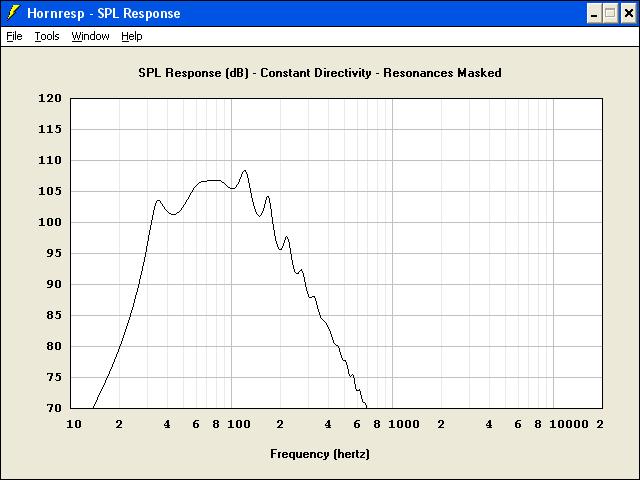 12π basshorn v1, single horn response
12π basshorn v1, single horn response
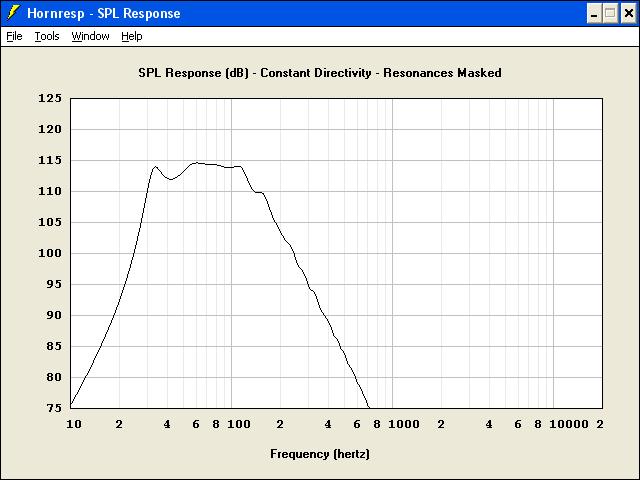 12π basshorn v1, group of four
12π basshorn v1, group of four
As you can see, the dip around 42Hz has grown in this version, due to rear chamber being smaller (40 liters) than the original design (50 liters). The dip is only about 2dB, which certainly isn't bad, especially for a basshorn. See the actual measurements of the v1 version basshorn at the 2006 Prosound Shootout. Owners of v1 version 12π basshorn subs are extremely pleased with their performance, arguably the best production basshorn subwoofer on the market. But it bothered me that this version wasn't as good as the prototype.
We have just completed a second version (v2) of the 12π basshorn subwoofer. We've learned that 27 liters is about as small as we can make the front chamber and still keep the design easy to build and service. So I decided that should be a fixed target, rather than the original design goal of 20 liters. With front chamber volume being fixed at 27 liters, I found the rear chamber volume that would make response be as flat as the original 20/50 design. What I found was that 54 liters was the optimal rear chamber volume when the front chamber was 27 liters. The motor chamber of the v2 (27/54) combination also took up the same space as the prototype (30/50), which keeps the flare profile layout spiraling around it perfectly.
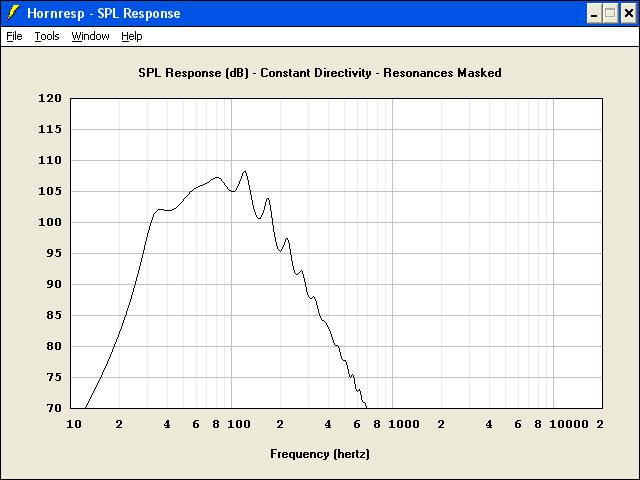 12π basshorn v2, single horn response
12π basshorn v2, single horn response
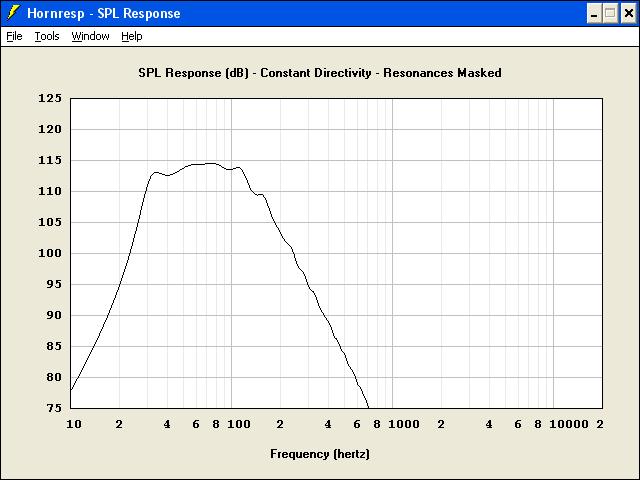 12π basshorn v2, group of four
12π basshorn v2, group of four
The 12π v2 basshorn subwoofer is a real winner, because it maintains the original design goals even better than the prototype did. It is truly a high-fidelity basshorn, with response that promises to be better than any basshorn sub I've seen. I'm very excited about it.
|
|
|
|
Current Time: Fri Dec 05 09:32:48 CST 2025
|







